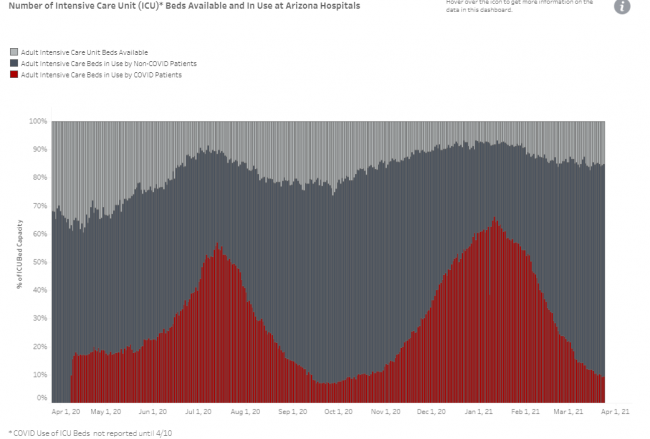No One In Power Has The Guts To Declare The Pandemic Over, So I Will: It's Over in Arizona
Half our politicians don't want to declare the pandemic over because they are wallowing in all their new power and having too much fun as petty dictators. The other half are scared, living in fear that every death after they declare an end will be used as the basis for a Bush-esque "mission accomplished" critique. Well, people will likely contract and perish from COVID forever. Heck, people died last year in this country of the whooping cough. My 25-year-old nephew died of regular old flu.
But if we define the pandemic as a time when a single disease drives excess mortality outside of normal bounds, then this pandemic is over, at least in AZ. As of this morning, 27% of people in AZ had at least one dose of the Pfizer or similar vaccine, over half of those being in the vulnerable over-65 group. We don't know how many have gotten the virus, but (non-random) anti-body tests were running over 50% positive last month. If we assume a third of folks have antibodies from the virus itself, and that there is a 50% overlap between these folks and those vaccinated, this gets us to nearly 45% immunity, rising by several percentage points each week. Immunity levels in the over-65 population may be over 80%.
As a result, cases have fallen sharply but due to the sensitivity of testing, I am not a fan of that metric. We will probably always have people testing positive. The question is whether people are getting seriously ill. And here are the numbers for that, I use ICU bed occupancy as a proxy for serious illness (because case numbers are exaggerated and death numbers have a crazy lag to them):
I am not cherry-picking -- this is the most useful metric, I think, but all the others show the same thing.
My suspicion has always been that "COVID patients" means "Patients who test positive for COVID," so the number may be a bit exaggerated for true hospitalizations caused by COVID. Also it is a lagging indicator -- 10 days to incubate and a week to end up in the hospital and perhaps a week stay in the hospital means these are likely folks exposed in early March. But the result is clear. Given the sensitivity of testing, these numbers will likely never go to zero. What we see is a normal hospital load form a seasonal virus, in fact one currently far smaller than what we might get in a normal flu season. In other words, we are back to normal. AZ, by the way, last week opened vaccines to everyone over 18.
Postscript: If you compare the ethnic data on COVID deaths vs. vaccines, it does appear Hispanic and native American groups are under-represented in the vaccine population vs. the population of COVID deaths, though the ethnic information on vaccine administration has a lot of gaps. This is partly predictable for Hispanic groups as they skew much younger than whites in AZ so the prioritization to over-65 people first is going to skew the racial mix.
That fact may get reported on. The fact that will not get reported on is the gender skew. In AZ men were 58% of deaths but are only 43% of those who have been vaccinated. I guess if I wanted to spend my life being aggrieved about my tribe I could be upset about this, but in fact it is entirely predictable from the vaccine priorities. Vaccines first went to teachers, health care workers, and old people -- all three of which skew heavily female.
Postscript #2: One interesting thing that I have not seen reported -- I don't know any men, including myself, who had any substantial reactions from the vaccine. My wife and daughter, however, were really knocked out for a day. This is partly random, but also partly the inevitable result of having a singles-size dose for everyone. The ladies in my family have much smaller body mass than I but got the same dose, which may explain why it hit them harder.
